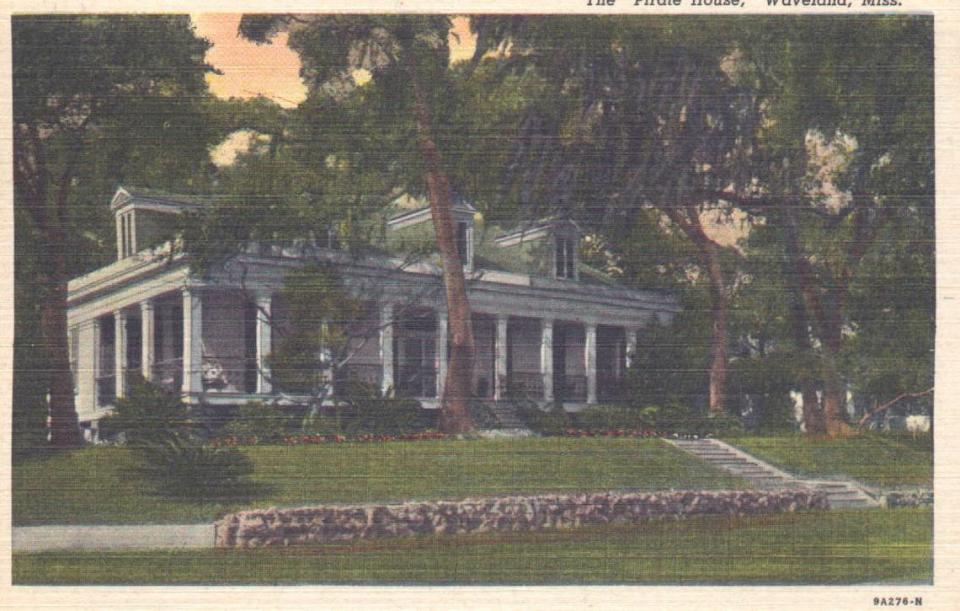Did an infamous New Orleans pirate live in this haunted mansion on the Mississippi Coast?
- Oops!Something went wrong.Please try again later.
Once tucked away in the coastal scenery, the Pirate House stood as a formidable and beautiful home before being destroyed by Hurricane Camille in 1969. To this day, its haunting legacy captivates the hearts of those who relish a good ghost story.
The Pirate House was built in 1802, mirroring the majestic plantations of Louisiana while drawing inspiration from the charm of New Orleans’ French Quarter. Over time, it transformed into a Greek Revival structure, becoming a notable landmark in the area.
Nestled among ancient oak trees and flanked by several ponds, the house boasted a feeling of secrecy. Locals speculate that these natural elements provided a shield of privacy, ideal for any shady activities that may have occurred within its walls.
According to local lore, the Pirate House played host to the notorious Jean Lafitte, a pirate lord based out of New Orleans. Although no concrete evidence supports this claim, the house did attract a motley crew of criminals, possibly affiliated with the infamous Lafitte.
Records indicate that one of the first occupants was a smuggler by the name of Antoine or Antonio Peytavin. Three pirate gunboats may have been stationed near Bay St. Louis to guard the Pirate House and its illegal activities during his occupancy.
Tales of pirate raids against shipping along the Gulf Coast add an air of adventure to the house’s history. However, the most lucrative enterprise for these pirates was the smuggling of illegal slaves, known then as “Black Ivory,” into Spanish New Orleans.
Legend has it that a hidden tunnel connected the Pirate House to the beach, enabling pirates to transport stolen treasures and captives discreetly. However, this secretive operation met its demise in 1807 when Spanish authorities stormed the house, putting an end to the illegal operation.

Dark rumors persisted, suggesting that the basement of the house served as a prison where slaves and prisoners suffered unimaginable horrors before their transport to New Orleans. Furthermore, a well in the backyard supposedly became the final resting place of three unfortunate souls, their restless apparitions occasionally seen wandering the premises.
Whispers of Jean Lafitte’s retirement to the Pirate House only added to the intrigue surrounding the legendary home. His relatives are thought to have changed their names and maintained ownership of several nearby properties.
As the 1900s arrived, the Pirate House stood as a testament to local architectural beauty, and its reputation extended beyond its physical presence. In 1928, construction workers allegedly unearthed portions of the long-forgotten secret tunnel.
Meanwhile, rumors of blood-smeared walls, ghostly apparitions, and bone-chilling screams began to circulate, weaving themselves into the fabric of local folklore. In the 1930s, one resident reported encountering a ghostly figure on the staircase, only for it to vanish in a blink of an eye.
A few years later, the Singreen family snapped a family portrait in the front of the home. To their surprise, they noticed the figure of a man in one of the upstairs windows. According to locals, the home was haunted by as many as 8 different ghosts, one of them supposedly being Jean Lafitte himself.
The home later passed to the Lister family, who felt that the home was not haunted by ghosts, but instead occupied by “visitants.” In 1969, Hurricane Camille damaged the house beyond repair, and the Lister’s salvaged the bricks and pieces that they could find.
Several neighbors have reported ghost sightings of pirates and other lost souls even to this day. Many others remain intrigued by the thought of buried treasure and other long lost secrets from the house.
Although the Pirate House has long been gone, the legends and haunting tales endure. The legacy of this dwelling, intertwined with its pirate lore, continues to captivate the imagination and leave a cultural mark on Waveland and the Mississippi Gulf Coast.

